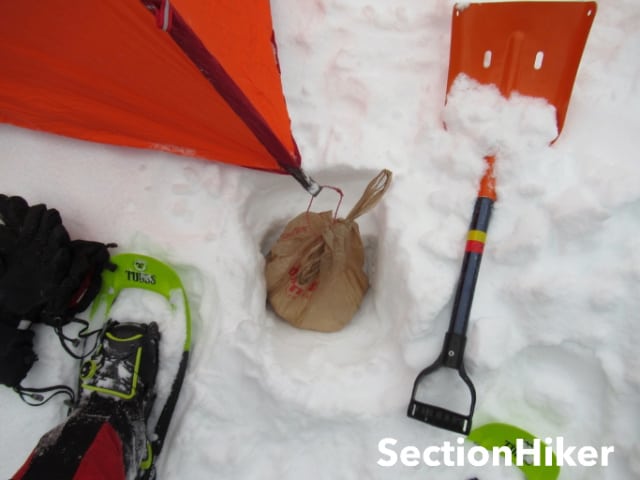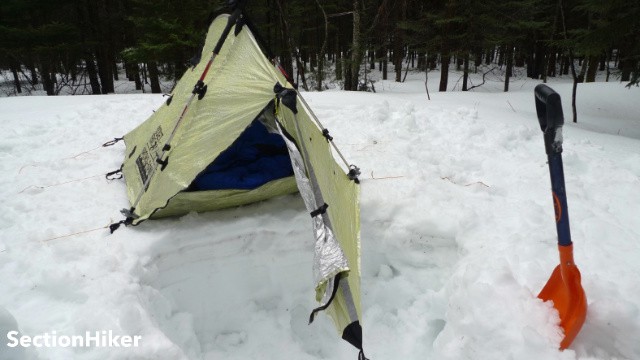
Many three-season tents can be used for winter camping or backpacking if you set them up below treeline, they have strong aluminum or carbon fiber tent poles, and you bring sufficient sleeping insulation and warm clothing to remain comfortable in cold weather. You can also make a three-season tent more comfortable in winter by building wind-breaks or enhanced vestibule areas out of snow if you bring an avalanche shovel with you.
Tent Poles
First, you need a tent that uses tent poles or trekking poles made with aluminum or carbon fiber and not tent poles made with fiberglass. It can be a double-wall tent or a single-wall tent. It doesn’t matter. Aluminum tent poles and trekking poles are strong enough to use in cold weather and under moderate snow loads on the roof of the tent, but fiberglass tent poles tend to shatter in cold temperatures when stressed. What’s a moderate snow load? To be conservative, let’s say 3″ of overnight snow. Less if the snow is saturated with water. It kind of depends on your tent, what shape it has, and how often you bang on the roof at night to keep snow from accumulating on top.

Insulation
Next, you’ll need clothing, a sleeping bag or quilt, and a sleeping pad sufficient to weather the temperatures you want to camp in. While a tent can prevent the wind from robbing your heat, thin tent walls don’t impart any insulation value beyond your clothing or sleep system. We recommend a sleeping pad with an R-value of 5 or more. This can be one pad or two stacked on top of the other since sleeping pad R-values are additive. Most people bring a folding foam pad, like a Therm-a-Rest Zlite sleeping pad, to sit on (instead of the snow) when cooking meals or melting snow, which can also be used as part of your sleep system. See our comprehensive list of sleeping pad R-values to look up your pad’s R-value.
Tent Anchors
When the ground is frozen solid or covered with a deep layer of snow, you can’t rely on regular tent stakes, conventional guyline tensioners, and guylines to stake your tent down for structural support or to prevent it from blowing away in the wind. The easiest thing to do is to grab an 8″ stick if you’re in a forested area, tie a guyline around it, and bury it in the snow so it freezes in place. This is called a deadman. Snow stakes (REI sells excellent blaze orange ones) serve the same purpose, but it helps to practice using them at home before doing it in the snow when you’re wearing heavily insulated gloves.

You can also stake out a tent with skis, ice axes, dismantled trekking poles, or snowshoes. Believe it or not, plastic supermarket shopping bags also make good deadmen. Fill one with snow. Tie it to your tent’s guyline and bury it in a hole you’ve dug with your avalanche shovel.

Avalanche Shovel
Avalanche shovels are compact shovels carried by winter backpackers and campers to create snow structures, including kitchen areas and walls made out of snow. Some have shovel blades that can be separated from the handle to make them easier to pack. You can use a shovel to create snow structures that augment your tent and make it more weather-worthy for winter camping.

For example, the rain fly or walls of most three-season tents, especially those of ultralight tents, seldom go all the way to the ground, but leave a big air gap for added ventilation. This is fine in hot weather, but it lets cold wind blow through the bottom of your tent in winter, which is most unpleasant and robs heat from your sleep system. You can fix this by piling snow up around the base of your tent like a low wall, cutting snow blocks and building a wall to block the wind, or by digging a shallow pit to set your tent up in. It’s Leave No Trace because it will all melt by spring.

It still helps to keep your tent door partially unzipped, especially toward the ceiling, to prevent moist air from collecting inside and creating frost on the walls, but it stops the wind in its tracks.
More Tips
Some double-wall three-season tents are available with interchangeable inner tents with insect netting for warmer weather and solid fabric walls for winter. The solid walls block wind to make you more comfortable. Tarptent provides this option on their Notch Li, Notch, Moment, and Hogback tents.

Most of Hilleberg’s tents have solid doors and walls for this same reason. Big Sky International and SlingFin also sell some tents with a solid inner. You can also find solid inners or partial inner tents on most of MSR’s winter tents, including the 4-season Access Tent Series. That’s just a partial list off the top of my head. If you’re shopping for a new tent and you want 4-season versatility, this is a good option to consider.
SectionHiker is reader-supported. We only make money if you purchase a product through our affiliate links. Help us continue to test and write unsponsored and independent gear reviews, beginner FAQs, and free hiking guides.
More Winter Backpacking Frequently Asked Questions
- Winter Backpacking Gear List Explained
- How to Keep Your Water Bottles from Freezing in Winter
- How to Choose a Hard Shell Jacket for Winter Hiking
- 10 Winter Hiking and Backpacking Hacks
- 10 More Winter Hiking and Backpacking Hacks






![Air gun 101: The differences between .177 & .22 – Which jobs they do best ? [Infographic]](https://airgunmaniac.com/wp-content/uploads/2020/09/g44-218x150.jpg)








































